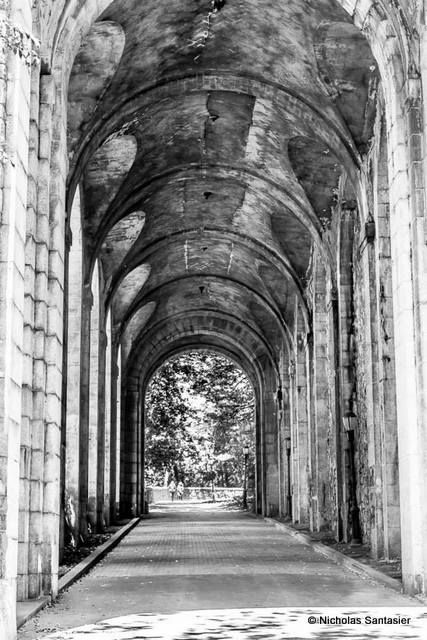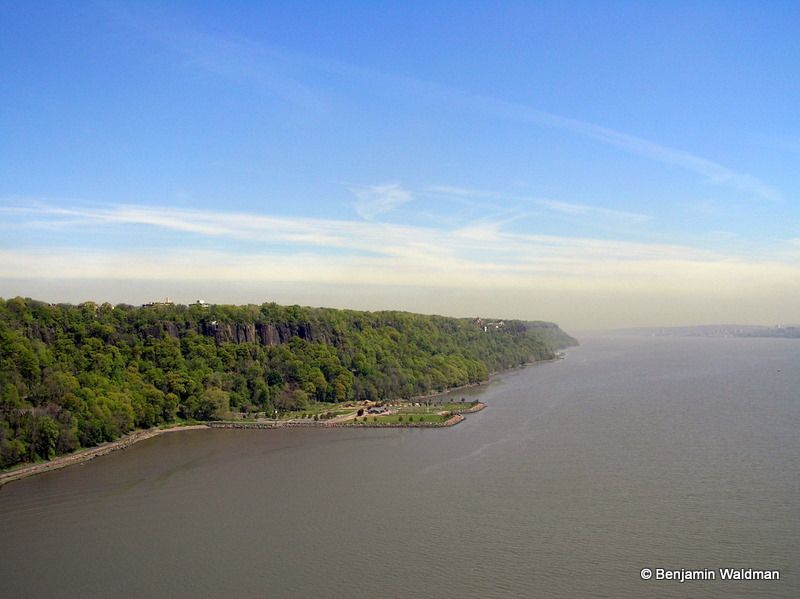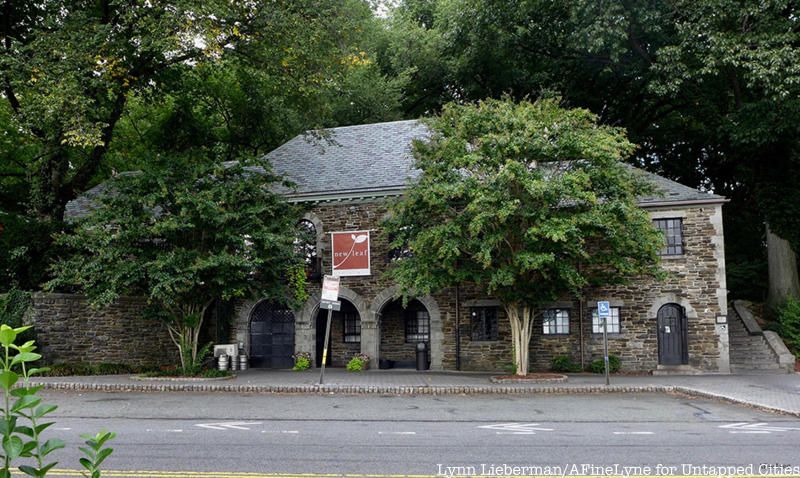Last Chance to Catch NYC's Holiday Notalgia Train
We met the voices of the NYC subway on our nostalgia ride this weekend!



Sitting at 200 feet above sea level, Fort Tryon Park is one of Manhattan’s highest points, offering some of the most impressive views of the Hudson River. Named after British Governor Sir William Tryon in honor of the British victory in the Battle of Fort Washington, the land was acquired by John D. Rockefeller, Jr. who hired the Olmsted brothers to design the striking park.
Fort Tryon Park was designated as an official New York City landmark in 1983, and has been a popular destination in the neighborhood due to its large variety of year-round activities and amenities. Often considered as “a bit out of the way” to Manhattan dwellers, here are 10 secrets about Fort Tryon Park that may get it on your New York bucket list.
Learn more about the secrets of Fort Tryon Park and Hudson Heights in our upcoming virtual tour! Get unlimited access to all of Untapped New York virtual events plus 100+ on-demand webinars. Become an Untapped New York Insider today for as low as $10/month! Already an Insider? Register here!

Photo from Library of Congress
The northern edge of Manhattan where Fort Tryon Park now sits was once a country estate where wealthy owners built extravagant estates. When Cornelius K.G. Billings, a wealthy industrialist and horseman from Chicago moved to New York in the early 19th century, he followed suit. By 1907, the C.K.G. Billings estate was completed with a 25,000 square foot lodge and stables, a magnificent mansion as well as a yacht landing on the Hudson River at Dyckman Street. The lodge which sat on the highest part of the estate offered views southward as far as the Statue of Liberty. Later in 1910 he commissioned to have the entire estate, including the interior, photographed, in order to document and showcase his wealth.

Although C.K.G. Billings’ mansion burned to the ground in the 1920s, Rockefeller salvaged the remaining structure and incorporated it into the park design. The massive structure which survived the fire is known as the Billings Arcade – a 50-foot arched structure which was the original driveway that meanders up the hill to the estate. It is part of a 1,600 foot long brick driveway that leads to the mansion through the Billings gatehouse – another surviving fragment renamed as the Fort Tryon Cottage.
Learn more about how a cow helped design this $250,000 driveway.

The New Jersey Palisades
For those who imagine Manhattan’s skyline to be solely comprised of high rise and skyscrapers, a trip to the top of Fort Tryon Park will surely change your mind. From here, the view of the Hudson River, the George Washington Bridge, the New Jersey Palisades and the Harlem River is absolutely breathtaking. In fact, this was what Rockefeller recognized when he purchased the park from C.K.G. Billings, because he also purchased the land on the New Jersey side of the river. Olmsted spent four years to transform the site into the beautiful landscape we see today, making sure to preserve open ares and the spectacular views of the Hudson and the Palisades.
Unfortunately in recent years, developments have been seen on south of the bridge on the Jersey side, including the proposed LG Corporation headquarters in Englewood Cliffs. At 143-feet, the office building will be more than four times what was permitted for the site. Despite resistance from New York lawmakers, it is up to New Jersey to make zoning decisions over the Palisades. As of October 2015, LG has agreed to reduce the building height to 69 feet, but is still negotiating with local environmentalists to finalize the design.

Tucked within the forestry of Fort Tryon Park is a fieldstone cottage built by John D. Rockefeller in the 1930s, which was restored by the New York Restoration Project (NYRP) in 1995. The non-profit organization was founded by entertainer Bette Midler in effort to transform valuable public spaces for communities in New York City. The New Leaf Restaurant & Bar, previously operated by NYRP was taken over by Coffeed, a Queens-based “charity-minded café and specialty coffee company.”
Whether for a casual lunch or special occasions, the restaurant’s popularity is clearly intact, often bustling with patrons especially on its recently resumed Friday Jazz nights.

Medieval gardens in front of the Cloisters
The Cloisters is a branch of The Metropolitan Museum of Art sitting on a four acre lot overlooking the Hudson River. Donated by philanthropist John D. Rockefeller Jr., the museum was intended to display the medieval art collection he acquired from art collector George Grey Barnard. The museum is a combination of a medieval monastery which was reconstructed stone-by-stone on site, and a new construction designed in the medieval style. It houses more than 2000 works of medieval European art and artifacts. One of the noteworthy pieces is the Unicorn Tapestries, a series of seven which Rockefeller bought in 1922 for about one million dollars.

A plaque honoring the heroic actions of Margaret Corbin during the Battle of Fort Washington, 1776.
When you enter the park from the south, coming out of the 190th Street subway station, you’ll first see a traffic circle called Margaret Corbin Circle that opens onto Margaret Corbin Drive which runs northwards through the park. Margaret Corbin from Pennsylvania was one of the female camp supports accompanying the First Company of Pennsylvania Artillery, to which her husband belonged. He fell in battle defending Fort Washington against the Hessian troops, who were hired by the British. She took control of John’s canon, and continued the fight.
Her canon was one of the last still firing in this battle, though she too was wounded. Fittingly, she became the first woman to receive a military pension due to the permanent severity of her battle wounds. She is only one of two Revolutionary soldiers buried at West Point, where her body was moved in 1926. There is a memorial to Corbin and her compatriots inside Fort Tryon Park, erected in 1909

The 3-acre Heather Garden is one of the highlights of Fort Tryon Park, hosting over 50 varieties of heaths and heathers which are surrounded by 200 varieties of perennials and shrubs. The garden is open to visitors all year round, featuring seasonal blooms and perpetually changing foliage. Funded by the Greenacre Foundation and the recent addition of the Fort Tryon Park Trust, the “crown jewel of the park” celebrated its 75th year in 2010.
Since then, the park has commissioned public garden designer Lynden Miller to develop a framework plan for the garden’s long term development. Known for her work in Bryant Park, Central Park’s Conservatory Garden, Madison Square Park, the Perennial Garden at the New York Botanical Garden as well as Columbia University, Miller will deliver an all-rounded approach to tackle horticulture challenges while preserving its “romantic feel and otherworldly aura”.

Manhattan’s one and only Medieval Festival takes place in the heart of Fort Tryon Park, bringing life to the customs and spirit of the Middle Ages. The event is organized by the Washington Heights & Inwood Development Corporation, a not-for-profit corporation and supported by the New York Department of Parks and Recreation.
Celebrating its 31st year, Fort Tryon Park will be transformed into a medieval market filled with bright decorations and authentic medieval music. Performances and activities will be offered to festival goers, as well as costumed vendors selling a wide range of arts and crafts as well as food and drink. Better yet, the festival is free- join the festivities this fall in the area surrounding to the Cloisters on Sept 18, 2016.

Photo courtesy Paul Kittas
Fort Tryon Park sits on a formation of Manhattan schist – an extremely strong bedrock that makes the city’s skyline possible. On the east and north end, the low-lying parts of the park are built on Inwood marble. As a part of their “Geologic City Project”, The American Museum of Natural History provides information about the park’s Pleistocene induced formations, including large glacial potholes and glacial striations from the last Ice Age.
Looking up from Riverside Drive on the west side of Fort Tryon Park will reveal the steep terrain of the landscape. For a better idea of how high the hill is, take a loop on the park drive that passes under a stone-clad bridge connecting to Margaret Corbin Drive. The parapet wall of the concrete bridge is clad in stone and is probably one of the highest arched masonry bridges in the city.

Looking into the next twenty years of Northern Manhattan’s park network, the NYC Parks’ Planning and Parklands Division, in conjunction with the Northern Manhattan Parks Administrator worked with the community to propose a master plan for the parks north of 155th Street. Involving more than 60 different organizations and $150 million in investment, almost 30 capital projects are already in various stages of design and construction.
The Fort Tryon’s Capital Projects include restoring Olmsted’s landscape plan which will reveal some of the internal views, creating bike connections to the Hudson River Greenway and enhancing community-focused areas. Learn more about the 2030 Master Plan at the NYC Department of Parks & Recreation website.
Nestled within Fort Tryon Park, the Sir William Dog Run boasts one of New York’s largest fenced-in dog runs. Named after Sir William Tryon, the last Colonial governor of New York, it is a short walk (uphill) from another park near Broadway and Dyckman. The one-acre park is completed with a gazebo and five picnic benches that overlook the Hudson River. There is even a section for smaller dogs to play.
Managed by the Fort Tryon Dog Owners Group, the park runs on funding from sponsors and volunteers. One of its largest supporters Spoiled Brats organizes a “coffee bark” every first Sunday of the month, offering doughnuts and coffee for dog-owners while their companions socialize. The park is frequently used by a tight community of dog lovers, and is kept clean all year round.
Next, check out the Top 10 Secrets of Central Park and The Top 12 NYC Nature Trails For Fall (and Year Round) Exploration
Subscribe to our newsletter